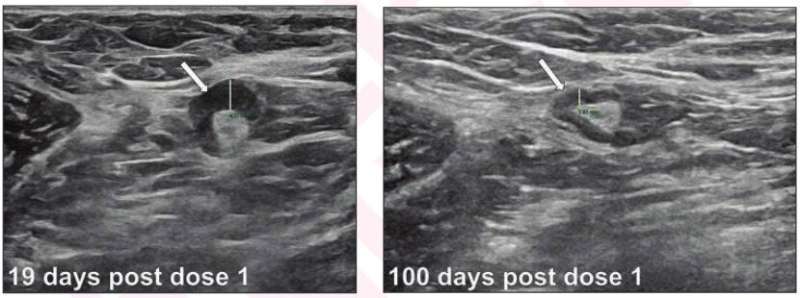Left: Transverse image of left axilla on initial breast ultrasound, 19 days after first dose of Pfizer COVID-19 vaccination to left upper extremity, demonstrates increased cortical thickness of 4 mm (arrow). Right: Transverse image of left axilla on follow-up ultrasound, 100 days after first COVID-19 vaccine dose, demonstrates cortical thickness of 2 mm (arrow), consistent with resolution of left axillary lymphadenopathy (arrow). Patient underwent second dose 2 days after initial ultrasound. Credit: American Roentgen Ray Society (ARRS)
According to ARRS' American Journal of Roentgenology (AJR), axillary lymphadenopathy detected by breast ultrasound after COVID-19 mRNA vaccination lasts longer than reported in initial vaccine clinical trials.
"The prolonged resolution time supports a follow-up interval of at least 12 weeks for suspected vaccine-related lymphadenopathy and avoidance of delaying screening mammography after vaccination," wrote corresponding author Michele B. Drotman, MD.
Drotman and the Weill Cornell Medicine team extracted health record data for 111 patients (mean age, 52 years) with unilateral axillary lymphadenopathy ipsilateral to administration of Pfizer or Moderna COVID-19 vaccine—performed within 8 weeks prior and detected on breast ultrasound (January 1–October 1, 2021) that underwent follow-up ultrasound examinations at 4–12 weeks.
In this single-center study, axillary lymphadenopathy ipsilateral to COVID-19 mRNA vaccination resolved after a mean of 97 days since detection by breast imaging and 127 days since the first dose. Longer times to resolution were observed with Moderna (rather than Pfizer) vaccination, receipt of second dose after presentation, and thicker cortical thickness at presentation.
"The presence of subclinical lymphadenopathy and the long resolution time of lymphadenopathy," the authors of this AJR article noted, "should reassure radiologists and patients when lymph nodes suspected to be vaccine-related persist over multiple visits."
More information: Elizabeth G. Lane et al, Time for Resolution of COVID-19 Vaccine-Related Lymphadenopathy and Associated Factors, American Journal of Roentgenology (2022). DOI: 10.2214/AJR.22.27687
Journal information: American Journal of Roentgenology
Provided by American Roentgen Ray Society
























